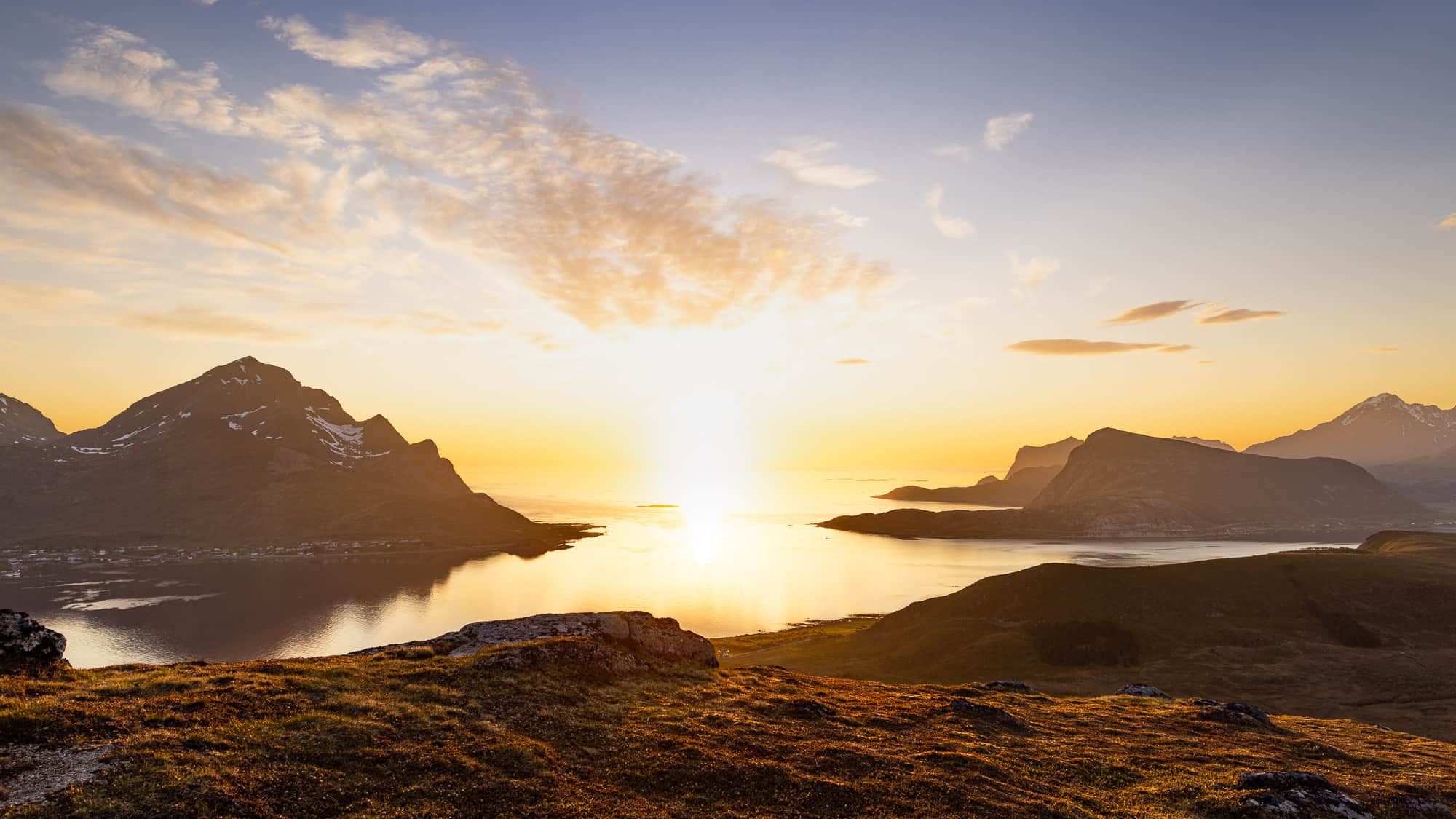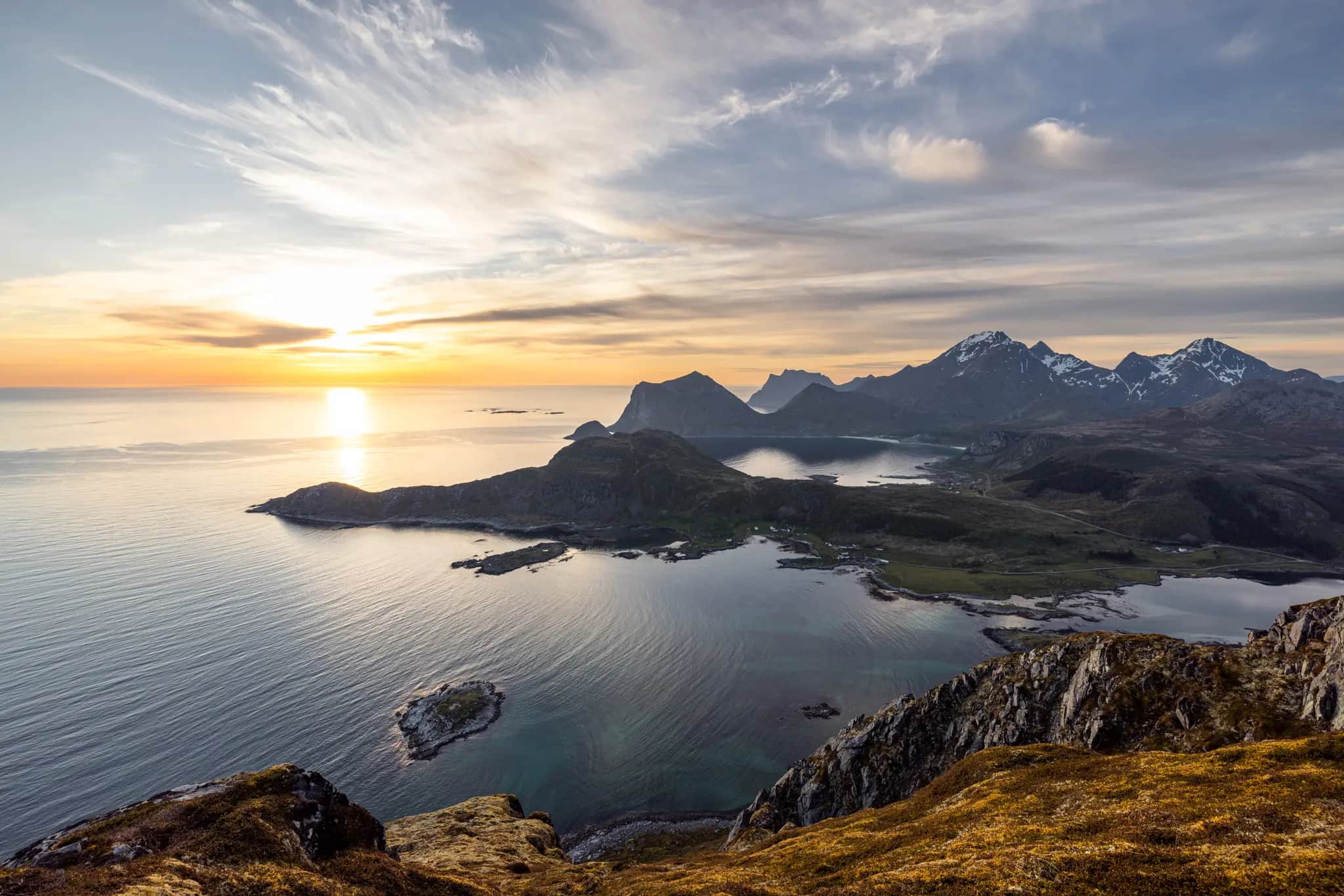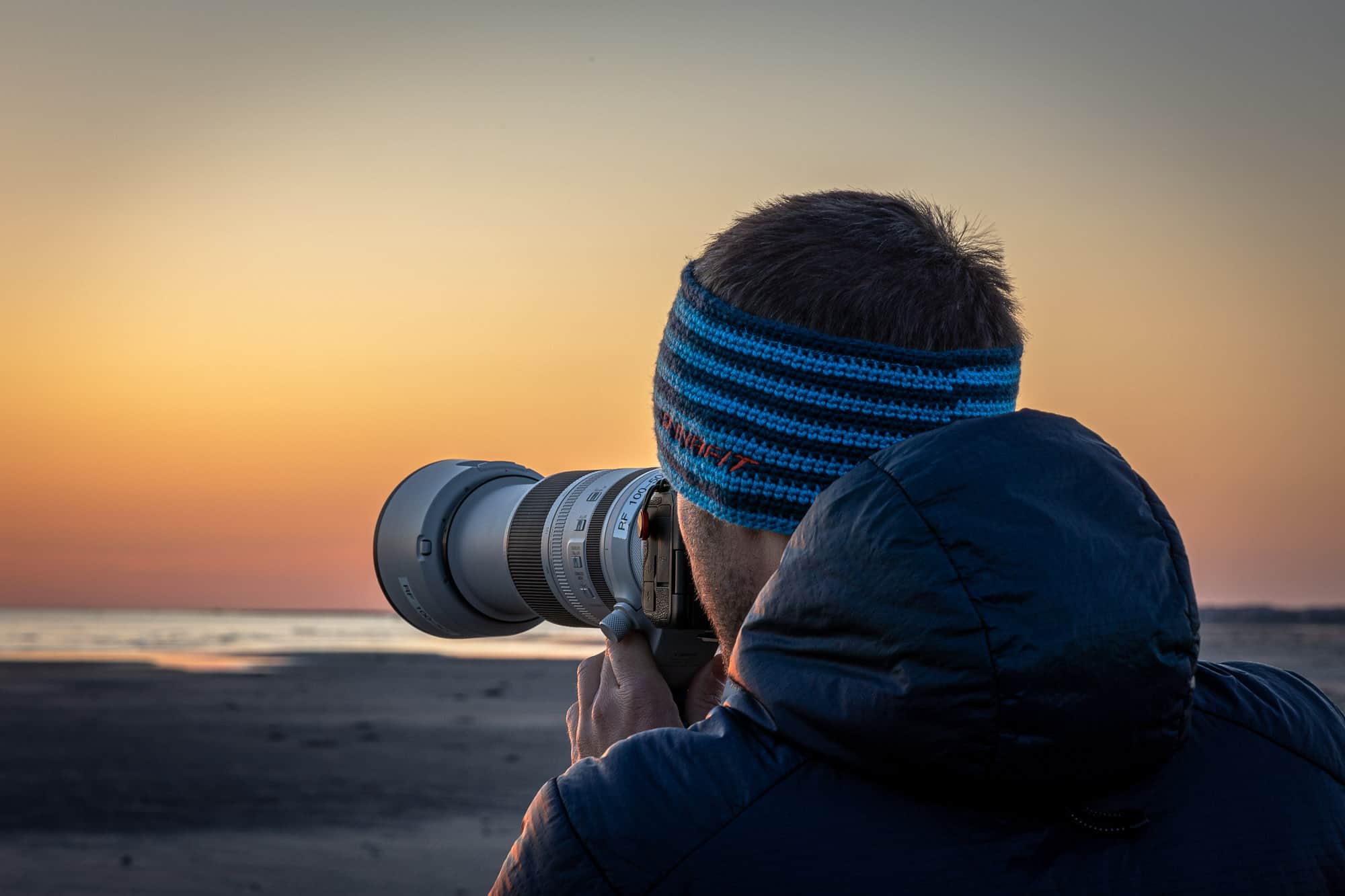When the sun doesn't set even at midnight and the world is bathed in a magical, golden light - that's when you experience the midnight sun in all its beauty. In our travel guide, you will find everything you need to know about this unique natural phenomenon. The focus is on the Lofoten Islands in northern Norway - one of the most impressive places to experience the spectacle up close. However, many of the tips and information also apply to other regions north of the Arctic Circle, such as Iceland, northern Sweden and Finnish Lapland.

Norway is known as the “Land of the Midnight Sun”, with continuous sunshine in all regions north of the Arctic Circle. If you want to experience the midnight sun on the Lofoten Islands in the north of Norway, you have around two and a half months to do so at these latitudes. Every year between the end of May and mid-July, the sun is above the horizon for 24 hours a day on the Lofoten Islands. In winter, however, the sun does not rise at all for some time during the polar night and does not rise above a diffuse twilight (the so-called polar night).
When does the midnight sun shine?
The midnight sun does not shine all year round. To be able to observe this natural phenomenon, you need to travel to Norway at the right time of year.
Generally speaking, you will find the best conditions in Scandinavia if you plan your trip between the end of May and the end of July. However, this does not mean that the effect of the midsummer night is not visible before and after, it is just not as strong. Midnight sun means above all that the sun does not set for 24 hours, i.e. it does not sink behind the horizon, or only partially, during this time. Nevertheless, you will also experience bright nights a few weeks before and after the time of the midnight sun, when it is still so bright at three o'clock in the morning that it will seem like daytime.
Briefly explained

Where can you experience the midnight sun in Norway?
The magical boundary for continuous sunshine is the Arctic Circle, which runs along the 66th parallel. Anywhere north of this, the sun does not set during the midsummer night, although the further north you go, the longer the period. However, to be able to admire the midnight sun for half a year, you would have to travel as far as the North Pole.
In the following list you will find some well-known places in Norway above the Arctic Circle with the respective period for the midnight sun:
From mid-June to the beginning of July, you naturally also have very long days and only a few hours without sunshine south of the Arctic Circle. So if you are in Trondheim, for example, you will also experience many hours of sunshine at the time of the summer solstice around June 21 and can enjoy the beautiful light of the low sun.

Activities under the midnight sun
Sleeping under the midnight sun? Sleep is still necessary, but especially difficult in the first few days - the sun's rays at night and the magical colors that bathe the norwegian landscape in a dreamlike light are too fascinating.
- Trail running: As keen outdoor sports enthusiasts, we definitely recommend trying trail running in the middle of the night. The varied trails in Lofoten are perfect for short and long runs with breathtaking views.
- Hiking**: Pack your backpack and set off on a hike - unforgettable panoramic views of the midnight sun from lonely peaks, scenic ridges and white sandy beaches in turquoise bays included.
- Kayaking**: There are many opportunities to hire kayaks in the Lofoten Islands. Paddle through the still, glittering water in the silence of the midsummer night and discover the Lofoten Islands from a completely new perspective.
The beauty of such activities is that you are not alone. During the time of the summer solstices, you will always meet locals and tourists who also want to enjoy this unique atmosphere.
Tip
When planning an activity in the midnight sun, bear in mind that the sun's path low on the horizon runs from west to north to northeast.
So if you are on the southern side of a mountain, you will see very little of the sun. On the north side, on the other hand, you will be rewarded with night-time sunshine in good weather.

What time of day is the sunlight most beautiful?
Of course, you don't have to get up in the middle of the night to marvel at the midnight sun. The beautiful light starts at around 9 pm - the perfect time after dinner. But getting up (very) early at three or four o'clock can also be really worthwhile and you will be able to observe the sun far north of its usual path in Central Europe with sunrise in the east.
Between 10 p.m. and 4 a.m. in the morning is the ideal time for observing and photographing. The sun reaches its lowest point between 1 and 2 a.m. before it begins its ascent again and reaches its highest point at 12 noon.
Note that many wild animals such as moose or reindeer** are also active during car journeys at night. The good light conditions help to see the animals in good time, but you should always drive carefully to avoid wildlife accidents.
The midnight sun on Lofoten and Vesterålen
On Lofoten and Vesterålen to the northeast, the midnight sun shines approximately between May 25 and July 18 (corresponding to the geographical location of Svolvær, roughly in the middle of Lofoten). The extraordinary landscape with its mountains rising out of the sea, white sandy beaches and picturesque fishing villages makes the Lofoten Islands a predestined destination for experiencing the midnight sun.
We love climbing a mountain peak late at night and watching the magical change of light.
Marina Kraus
The beautiful and famous sandy beaches of Lofoten, such as Kvalvika, Haukland or Uttakleiv are also great destinations for a few hours of sun worship in the midnight sun - their west to north-west orientation is also ideal for having a clear view of the sun.
Some of the peaks that are well suited for observing the midnight sun due to their location:
- Hike up Nonstinden near Ballstad with great views of the Norwegian mainland and the plain of Leknes (Vestvågøy)
- The Guratinden also provides great views of this region of Lofoten, but towards the west and thus directly into the never-setting sun
- The solitary hike on Moltinden is also ideal for admiring the sun's rays and the impressive landscape in all directions
This list is of course not exhaustive and you can experience impressive moments on pretty much every elevation and summit.
Excursus: The Arctic Circle - boundary line of sunlight
Crossing the Arctic Circle in northern Norway means crossing an inhospitable plateau, north of Mo i Rana and south of Fauske in the Nordland region. At an altitude of just under 700 meters, we are reminded in no uncertain terms that we are now crossing the 66th parallel and are therefore only a good 2600 kilometers away from the North Pole. The same principle applies in the southern hemisphere, where the southern polar circle also marks the area where the sun does not set during the summer months due to the Earth's rotation.
The position of the polar circles is not fixed; it varies by almost 15 meters within 365 days, as their exact positions depend on the angle of the Earth's axis in relation to the plane of the orbit. The Earth's axis is inclined by 23.27 degrees in relation to its orbit around the sun. This effect (also known as the obliquity of the ecliptic) means that we can experience four different seasons every year on our Earth in both the southern and northern hemispheres - spring, summer, fall and winter. And it is also responsible for the fact that we no longer experience a sunset during our journey north thanks to this inclination, as the sun's rays always hit the earth's surface at least at a flat angle.
Photographing in the midnight sun
For photographers, the time during the midnight sun is a real stroke of luck - they are always on the lookout for the perfect light. You should observe the following three rules when photographing to ensure that you take impressive pictures during these special conditions:
- Be sparing with overly colorful motifs: Pick subtle subjects, as the colors are already very bright and colorful anyway due to the low sun. Too much color can ruin your picture and make it look restless.
- Sharp pictures without blurring**: Use a tripod if possible, because despite the sun shining throughout, there is less daylight than during the day and you will need to use longer exposure times. A good, lightweight travel tripod will prevent blurred and out-of-focus images.
- Avoid pictures that are too bright or too dark**: For subjects where you are shooting directly into the sun or just next to it, the camera must be able to cope with a large difference in brightness (known as the dynamic range). Make sure that you focus on a point that is neither in the brightest nor the darkest area of your picture, otherwise your photo will be underexposed or overexposed.
Photography courses
Do you dream of capturing the midnight sun with your camera? We will put together a customized photo trip for you - according to your wishes and your pace. Get in touch with us now and let's plan your midsummer night's adventure together!

Traditions under the midnight sun
In Norway, the time of the midnight sun is celebrated with lively traditions close to nature - first and foremost with the Saint Hans Festival on June 23. This midsummer festival has its origins in ancient pagan sun cults and is celebrated today with large bonfires by the water. Families and groups of friends gather on beaches or fjords, barbecue, sing and celebrate until long after midnight in the golden light of the never-setting sun.
Spontaneous night-time picnics and outdoor barbecues are also an integral part of the Norwegian summer: anyone who can spends the long, bright nights outside - preferably with a view of the sea or in the mountains. Popular activities include kayaking, fishing, hiking or simply marveling at the glowing landscape. The special lighting mood gives even simple moments an almost magical atmosphere that you won't soon forget.
Another highlight are concerts and festivals under the midnight sun, where music, nature and light merge in a unique way. Particularly popular is the Midnight Sun Marathon in Tromsø - a running event in the middle of the night where the sun never sets. In Norway, the midnight sun is much more than just a natural phenomenon - it is a living culture, a joy of life and a deep expression of the connection with nature.
Pure Light.
The midnight sun at home.More than worth a visit: the Lofoten Islands in the midnight sun
Whether for enjoyment or sporting action, for photography or for a relaxing stroll along the beach: a visit to the land of the midnight sun will probably not be enough. Norway's unique landscape with its rugged coastline is too captivating. White sandy beaches alternate with rocky cliffs, nestled between gentle hills and rugged mountain peaks. In addition, there is exclusive light from the midnight sun, including a guarantee of long nights with little sleep.
FAQs about the midnight sun
Still have questions about the midnight sun? We have compiled the most important information for you.
Our biorhythm is strongly oriented towards the natural alternation of light and dark - light means awake, dark means asleep. In regions with midnight sun, such as the Lofoten Islands, this balance can be disturbed. The hormone melatonin, which causes tiredness, is only produced to a limited extent when there is too much light, which makes it difficult to fall asleep. Photography enthusiasts](/landscape-photography) in particular quickly fall into a vicious circle of constant light, the golden hour and the urge to capture every scene. The result: a growing lack of sleep, because the bed often remains empty as long as there is dreamlike light outside. Only when exhaustion takes over does the body allow itself some rest.
The midnight sun disrupts our natural day-night rhythm, as it remains daylight even at night. This affects the body's own production of melatonin - the hormone that makes us tired. In Nordic countries such as Norway, light-proof curtains are therefore standard in bedrooms to ensure a good night's sleep despite the brightness. For tourists, a disturbed rhythm is usually only a temporary challenge. However, those who live permanently in the far north need a certain amount of discipline to deal with the long, bright nights. With the right measures - such as darkening rooms at bedtime - melatonin production can be regulated and the magic of midsummer nights can still be enjoyed. After all, sunlight lifts your mood and also contributes to your health.
Animals in the far north, such as reindeer and moose, also react to the midnight sun. Researchers have found that their biological rhythms are disrupted during this time: sleeping and feeding times no longer follow a clear daily pattern, but appear to be random. Only with the onset of longer nights in autumn does their behavior return to normal and follow the usual alternation of day and night. This means that you have a good chance of seeing reindeer, moose and other wild animals even during the midnight sun - they are still active, albeit at unusual times.
Between the end of May and the end of July, the midnight sun is in the sky north of the Arctic Circle. During this time, the sun does not set at night - it stays light around the clock. This unique natural phenomenon can be experienced particularly impressively in the Lofoten Islands or other regions in the far north.
The duration of the midnight sun depends on how far north of the Arctic Circle you are. The further north you are, the longer the sun remains visible around the clock. Directly at the Arctic Circle, the phenomenon only lasts a few days, while at the North Pole the sun shines around the clock for around six months. In Tromsø, which is around 350 kilometers north of the Arctic Circle, you can observe the midnight sun from around 18 May to 25 July.
June 21 is the day of the summer solstice - this is when the sun reaches its highest orbit in the sky and remains fully visible around the clock, even in the northernmost regions. It does not even partially sink behind the horizon. This date marks the peak of the midnight sun. From this point onwards, the days slowly become shorter again until the polar night sets in during the winter in the same regions.
The opposite of the midnight sun is the polar night. It occurs in the northernmost regions of Scandinavia during the winter months - especially in December and January. During this time, the sun remains completely below the horizon for weeks at a time and it doesn't really get light during the day either. Instead of sunlight, there is only a faint twilight at midday. The polar night is the winter counterpart to the midnight sun and an equally impressive natural phenomenon.
The midnight sun is the time when the sun does not disappear or only partially disappears behind the horizon during the night. It remains visible even at the lowest point of its daily orbit. This natural phenomenon occurs in regions north of the Arctic Circle and ensures that it remains bright around the clock - even at midnight.
Midsummer Night is the time of long, bright nights around the summer solstice when it hardly gets dark - a special natural experience in the Nordic countries. This period is celebrated with traditional festivals in Scandinavia: In Norway and Denmark it is called the Saint Hans festival, in Sweden Midsommar is celebrated, and in Finland the festival is called Juhannus. Typical festivities include bonfires, wreaths of flowers, music, dancing and socializing - often in nature, on the water or in the countryside.













